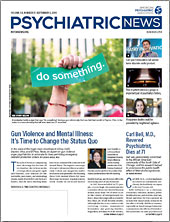Telehealth has the potential to redistribute the psychiatry workforce by leveraging technology to reach patients under a variety of circumstances and confer with distant patients and colleagues.
“Telehealth expands the opportunities for us to engage patients and to break down the barriers that keep them from engaging with us,” said Patrick Runnels, M.D., chair of APA’s Council on Advocacy and Government Relations. For instance, telehealth allows psychiatrists to reach patients living in rural areas where the closest psychiatrist may not be within a reasonable driving distance and patients whose full-time jobs prevent them from attending midday appointments. With telehealth, psychiatrists also can reach patients who are housebound due to anxiety or disruptive behavior and patients with serious mental illness who are incarcerated and would otherwise go without needed care.
Jay Shore, M.D., M.P.H., chair of APA’s Committee on Telepsychiatry and director of telemedicine at the Depression Center at the University of Colorado Anschutz Medical Campus, acknowledged that while telehealth is not necessarily a panacea for the overall mental health workforce shortage, “if leveraged appropriately, telehealth can help shift the models of care.”
In one such model, a psychiatrist can use telehealth to virtually manage a large panel of patients who are under the regular care of a primary care provider. In another model, a team of centrally located psychiatrists can virtually staff many geographically dispersed emergency departments, allowing the psychiatry team to assess patients and decide treatment promptly and cost effectively.
A large evidence base supports the use of telepsychiatry and shows that it performs as well or better than in-person delivery of mental health services—particularly when it comes to cost-effectiveness, according to a 2016 analysis of more than 100 peer-reviewed research studies.
At the same time, telehealth gives psychiatrists greater flexibility to work from home or while traveling, which can reduce stress and time spent commuting and allow for a better work-life balance.
Despite the promise it holds, many barriers stand in the way of wider adoption of telehealth, including lack of reimbursement, state licensure requirements, rules governing the prescription of controlled substances, and technology issues such as insufficient access to broadband.
Perhaps the biggest hurdle for these innovative tele-models is billing and reimbursement, particularly for team meetings, case management, telephone consultations with other health care professionals, provider-to-provider education, and care coordination, Shore said.
With regard to private insurance companies, coverage of telepsychiatry is hard to pin down and varies from plan to plan, said Jessica Thackaberry, M.D., an assistant professor of clinical psychiatry at the University of California, San Diego. “You need to be very specific” when calling private insurance companies to determine coverage, she said. “I ask them if they cover tele-mental health video visits with the patient in the home.” Most often she does not get a definitive answer, she said.
Coverage for telehealth services for Medicare and Medicaid patients is extremely limited, although there has been some progress. In 2018 the Centers for Medicare and Medicaid Services (CMS) expanded physician reimbursement for the Collaborative Care Model. “It’s a step in the right direction, but there are other evidence-based models out there that are still not covered,” Shore said.
Last year, APA successfully lobbied for a provision in the SUPPORT for Patients and Communities Act of 2018 (SUPPORT Act) that eases restrictions on reimbursements to psychiatrists who use telehealth to treat Medicare enrollees with substance use disorders (SUD): As of July 1, such patients may be treated for SUD or other co-occurring mental illness in their own homes via telehealth. APA wants to build on this progress and gain coverage for telepsychiatry care in enrollees’ homes, regardless of diagnosis.
State licensure rules are another major barrier in telepsychiatry, said Edward Kaftarian, M.D., the chair and CEO of Orbit Health Telepsychiatry, which employs 70 health care professionals working via telehealth in four states.
“With my California driver’s license, I can drive anywhere in the United States, but my California medical license allows me to see patients who are located in California only,” he said. “That’s a real problem because the distribution of psychiatrists does not necessarily match the geographic areas that have the greatest need for mental health care. Psychiatrists often prefer to live in major cities and on the coasts, yet there are many people in rural America or the Midwest with unmet mental health care needs due to a major shortage of psychiatrists.”
Another hurdle is the Ryan Haight Act of 2009, a federal law that generally prohibits physicians from prescribing controlled substances to patients via telemedicine unless the physician has conducted at least one in-person exam. One of the exceptions to this requirement requires telemedicine practitioners to obtain a special certificate; however, due to the lack of regulations surrounding this certificate, practitioners could not apply for it. However, last year’s opioid bill (the SUPPORT Act) required the Drug Enforcement Administration to issue these regulations by October, which as of press time had not been issued. As a result, the rules for prescribing controlled substances for psychiatrists treating patients via telehealth remain unclear.
There can be technology hurdles, too: “Lower-income patients or patients who live in rural areas don’t always have regular access to Wi-Fi or the consistent broadband needed to sustain a conversation,” Thackaberry said. With greater use of telehealth on the horizon, Shore would like to see more training for medical students and residents on how to best use it for patient care, as well as changes to allow student loan reimbursement for physicians who use telehealth to treat patients living in health professional shortage areas, a benefit currently reserved only for on-site physicians.
When it comes to changing the nation’s laws and regulations governing telehealth, Thackaberry said, many misconceptions remain. “Recently, when speaking with a group of lawmakers in Sacramento, I brought up telemedicine as a solution to address access issues for patients with substance use disorder, and I was told that this was a lower standard of care,” she said.
Evidence shows this is not true. “Telemedicine provides the same standard of care, and a lot of times it is preferred by patients and doctors. A lot of education needs to be done with legislators and their staff.” ■
More information about the CMS rule on telehealth for SUD treatment is posted
here. “Review of Key Telepsychiatry Outcomes” is posted
here. APA members who are interested in becoming involved in APA’s advocacy activities should visit
here.


